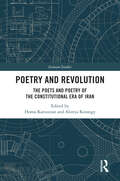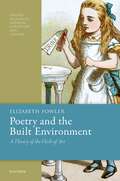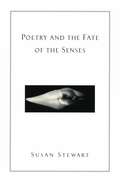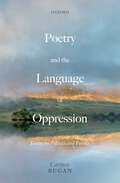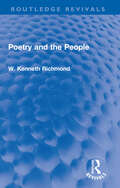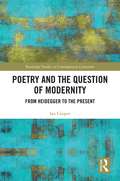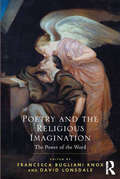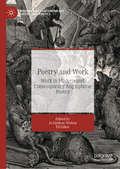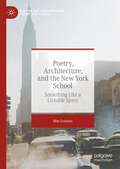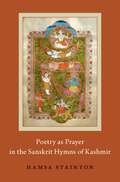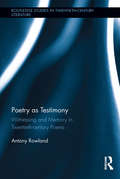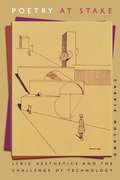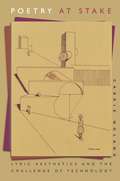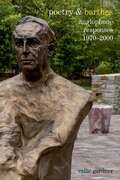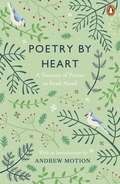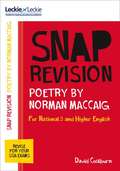- Table View
- List View
Poetry and Revolution: The Poets and Poetry of the Constitutional Era of Iran (Iranian Studies)
by Homa Katouzian Alireza KorangyCompiled by experts on the works of each individual poet, this book covers the poetry and poets of the Constitutional Revolution of Iran. Following a two-pronged approach, this volume studies both those who were influenced by the Constitutional Revolution in their works and those who addressed the Revolution with their work, influencing it directly. Through the analysis of their works, this volume explores influential poets and writers from the period, including Iraj, Vaziri, Afrāshteh, Yazdi, Bahār and ‘Eshqi. It covers female poets who are often overlooked, as well as the major satirical poets whose work educated and entertained the readers and criticized socio-political events. Analysing the mainstream and marginal poets, this volume argues the margins initiated the evolution of Persian poetry. As Persian poetry and its multifunctional legacy became the standard-bearer of the Constitutional movement, this volume is an important contribution to an understanding of Iran. This volume will be of interest to historians of the Constitutional Revolution and Iranian poetry, as well as to students and scholars of comparative revolutions. It is suitable for both undergraduate and graduate courses on Iranian history, Middle Eastern history and comparative studies of literature and revolution.
Poetry and Sustainability in Education (Palgrave Studies in Education and the Environment)
by Sandra Lee Kleppe Angela SorbyThis edited collection offers educators at all levels a range of practical and theoretical approaches to teaching poetry in the context of environmental sustainability. The contributors are keenly aware of the urgency facing the planet’s ecosystems—ecosystems which include all of us—and this volume makes the case that teaching poetry is not a luxury. Each of the book’s three sections works from a specific angle and register. Part I focuses on pragmatic approaches to classroom activities and curricular choices; Part II considers policies and politics, including the role of the UN’s Education for Sustainable Development (ESD) program; and Part III takes a widescreen view, exploring the philosophical issues that arise when poems are integrated into sustainability curricula. This book exemplifies how poetry empowers readers to think imaginatively about how to sustain—and why to sustain—our world, its resources, and its beauty.
Poetry and the Built Environment: A Theory of the Flesh of Art (Oxford Studies in Medieval Literature and Culture)
by Elizabeth FowlerIn Poetry and the Built Environment Elizabeth Fowler offers a new approach to criticism that recognises poetry as one among the arts of the built environment. Like gardens, sculptures, paintings, and architecture, poems are cultural artifacts designed to appeal to human bodies. The phrase "the flesh of art" signifies the sphere of interaction between us and such artifacts and signals the phenomenological nature of the approach. As we move through the built environment, we draw on our achieved expertise in negotiating its complex instructions to us. Art mobilizes this expertise, deploying sophisticated conventions and entangling the virtual with the real. As we engage with them, poems, like other artifacts, support skilled collaborations of the sensate (our perceiving flesh) and the sensible (the perceptible properties of the artifact), further developing our kinesthetic and cultural expertise. The notion of collaboration is important, because no matter how powerfully art twists our arms, moves, or injures us, there is always the interesting likelihood that our divergent bodies will contravene its instructions and take its insights somewhere new. In ten chapters, this book explores a range of works by poets Geoffrey Chaucer and John Milton to Seamus Heaney and Tracy K. Smith and by sculptors and architects from Jean de Touyl and Nicholas Stone to Antonin Mercié and Kara Walker. These studies model a practical criticism of the flesh of art that exposes its radiant invitations. The book's critical demonstrations partner with a theory of the central role of art in human culture. Sensory, emotional, and intellectual interactions with art enflesh and acculturate human beings, making art a primary means through which we orient ourselves in spatiality and work out our emplacements in the social world. This book about poetics takes place, in short, at the juncture between aesthetics and politics. It concludes with 43 theses in manifesto and includes many whole poems and 35 striking images. Poetry and the Built Environment insistently demonstrates art's ability to shape our understandings and practices of spatiality, movement, sensation, relation, and presence. In poetry, it argues, we see how, especially when the transparency and sensibleness of the world is under stress, art equips us with strategies for transformation.
Poetry and the Fate of the Senses (Phoenix Poets Ser.)
by Susan StewartWhat is the role of the senses in the creation and reception of poetry? How does poetry carry on the long tradition of making experience and suffering understood by others? With Poetry and the Fate of the Senses, Susan Stewart traces the path of the aesthetic in search of an explanation for the role of poetry in our culture. The task of poetry, she tells us, is to counter the loneliness of the mind, or to help it glean, out of the darkness of solitude, the outline of others. Poetry, she contends, makes tangible, visible, and audible the contours of our shared humanity. It sustains and transforms the threshold between individual and social existence. Herself an acclaimed poet, Stewart not only brings the intelligence of a critic to the question of poetry, but the insight of a practitioner as well. Her new study draws on reading from the ancient Greeks to the postmoderns to explain how poetry creates meanings between persons. Poetry and the Fate of the Senses includes close discussions of poems by Stevens, Hopkins, Keats, Hardy, Bishop, and Traherne, of the sense of vertigo in Baroque and Romantic works, and of the rich tradition of nocturnes in visual, musical, and verbal art. Ultimately, Stewart explores the pivotal role of poetry in contemporary culture. She argues that poetry can counter the denigration of the senses and can expand our imagination of the range of human expression. Poetry and the Fate of the Senses won the 2004 Truman Capote Award for Literary Criticism in Memory of Newton Arvin, administered for the Truman Capote Estate by the University of Iowa Writers' Workshop. It also won the Phi Beta Kappa Society's 2002 Christian Gauss Award for Literary Criticism.
Poetry and the Language of Oppression: Essays on Politics and Poetics
by Carmen BuganA first-hand account of the creative process that engages with the language of oppression and with politics in our time. How does the poet become attuned to the language of the world's upheaval? How does one talk insightfully about suffering, without creating more of it? What is freedom in language and how does the poet who has endured political oppression write himself or herself free? What is literary testimony? Poetry and the Language of Oppression is a consideration of the creative process that rests on the conviction that poetry is of help in moments of public duress, providing an illumination of life and a healing language. Oppression, repression, expression, as well as their tools (prison, surveillance, gestures in language) have been with us in various forms throughout history, and this volume represents a particular aspect of these conditions of our humanity as they play out in our time, providing another instance of the communion, and sometimes confrontation, with the language that makes us human.
Poetry and the Language of Oppression: Essays on Politics and Poetics
by Carmen BuganA first-hand account of the creative process that engages with the language of oppression and with politics in our time. How does the poet become attuned to the language of the world's upheaval? How does one talk insightfully about suffering, without creating more of it? What is freedom in language and how does the poet who has endured political oppression write himself or herself free? What is literary testimony? Poetry and the Language of Oppression is a consideration of the creative process that rests on the conviction that poetry is of help in moments of public duress, providing an illumination of life and a healing language. Oppression, repression, expression, as well as their tools (prison, surveillance, gestures in language) have been with us in various forms throughout history, and this volume represents a particular aspect of these conditions of our humanity as they play out in our time, providing another instance of the communion, and sometimes confrontation, with the language that makes us human.
Poetry and the People (Routledge Revivals)
by W. Kenneth RichmondFirst published in 1947, Poetry and the People presents a survey of English poetry from the earliest times till 1940s, viewed from an unusual angle. It is the author’s thesis that English Poetry is unpopular, in the sense that it is not loved by the people, because the sources of its inspiration, which were originally drawn from the soil, were diverted during the Renaissance into aristocratic and academic channels. Nevertheless, the emerging traditions, though driven underground, survived in the work of such men as Burns, Hogg and Clare and in folk song. This book is a must read for scholars and researchers of English poetry and English literature.
Poetry and the People (Routledge Revivals)
by W. Kenneth RichmondFirst published in 1947, Poetry and the People presents a survey of English poetry from the earliest times till 1940s, viewed from an unusual angle. It is the author’s thesis that English Poetry is unpopular, in the sense that it is not loved by the people, because the sources of its inspiration, which were originally drawn from the soil, were diverted during the Renaissance into aristocratic and academic channels. Nevertheless, the emerging traditions, though driven underground, survived in the work of such men as Burns, Hogg and Clare and in folk song. This book is a must read for scholars and researchers of English poetry and English literature.
Poetry and the Question of Modernity: From Heidegger to the Present (Routledge Studies in Contemporary Literature)
by Ian CooperInterest in Martin Heidegger was recently reawakened by the revelations, in his newly published ‘Black Notebooks’, of the full terrible extent of his political commitments in the 1930s and 1940s. The revelations reminded us of the dark allegiances co-existing with one of the profoundest and most important philosophical projects of the twentieth century—one that is of incomparable importance for literature and especially for poetry, which Heidegger saw as embodying a receptiveness to Being and a resistance to the instrumental tendencies of modernity. Poetry and the Question of Modernity: From Heidegger to the Present is the first extended account of the relationship between Heidegger’s philosophy and the modern lyric. It argues that some of the best-known modern poets in German and English, from Paul Celan to Seamus Heaney and Les Murray, are in deep imaginative affinity with Heidegger’s enquiry into finitude, language, and Being. But the work of each of these poets challenges Heidegger because each appeals to a transcendence, taking place in language, that is inseparable from the motion of encounter with embodied others. It is thus poetry which reveals the full measure of Heidegger’s relevance in redefining modern selfhood, and poetry which reveals the depth of his blindness.
Poetry and the Question of Modernity: From Heidegger to the Present (Routledge Studies in Contemporary Literature)
by Ian CooperInterest in Martin Heidegger was recently reawakened by the revelations, in his newly published ‘Black Notebooks’, of the full terrible extent of his political commitments in the 1930s and 1940s. The revelations reminded us of the dark allegiances co-existing with one of the profoundest and most important philosophical projects of the twentieth century—one that is of incomparable importance for literature and especially for poetry, which Heidegger saw as embodying a receptiveness to Being and a resistance to the instrumental tendencies of modernity. Poetry and the Question of Modernity: From Heidegger to the Present is the first extended account of the relationship between Heidegger’s philosophy and the modern lyric. It argues that some of the best-known modern poets in German and English, from Paul Celan to Seamus Heaney and Les Murray, are in deep imaginative affinity with Heidegger’s enquiry into finitude, language, and Being. But the work of each of these poets challenges Heidegger because each appeals to a transcendence, taking place in language, that is inseparable from the motion of encounter with embodied others. It is thus poetry which reveals the full measure of Heidegger’s relevance in redefining modern selfhood, and poetry which reveals the depth of his blindness.
Poetry and the Religious Imagination: The Power of the Word (The Power of the Word)
by David Lonsdale Francesca Bugliani KnoxWhat is the role of spiritual experience in poetry? What are the marks of a religious imagination? How close can the secular and the religious be brought together? How do poetic imagination and religious beliefs interact? Exploring such questions through the concept of the religious imagination, this book integrates interdisciplinary research in the area of poetry on the one hand, and theology, philosophy and Christian spirituality on the other. Established theologians, philosophers, literary critics and creative writers explain, by way of contemporary and historical examples, the primary role of the religious imagination in the writing as well as in the reading of poetry.
Poetry and the Religious Imagination: The Power of the Word (The Power of the Word)
by David Lonsdale Francesca Bugliani KnoxWhat is the role of spiritual experience in poetry? What are the marks of a religious imagination? How close can the secular and the religious be brought together? How do poetic imagination and religious beliefs interact? Exploring such questions through the concept of the religious imagination, this book integrates interdisciplinary research in the area of poetry on the one hand, and theology, philosophy and Christian spirituality on the other. Established theologians, philosophers, literary critics and creative writers explain, by way of contemporary and historical examples, the primary role of the religious imagination in the writing as well as in the reading of poetry.
Poetry and Work: Work in Modern and Contemporary Anglophone Poetry (Modern and Contemporary Poetry and Poetics)
by Jo Lindsay Walton Ed LukerPoetry and Work offers a timely and much-needed re-examination of the relationship between work and poetry. The volume questions how lines are drawn between work and non-work, how social, political, and technological upheavals transform the nature of work, how work appears or hides within poetry, and asks if poetry is work, or play, or something else completely. The book interrogates whether poetry and avant-garde and experimental writing can provide models for work that is less alienated and more free. In this major new collection, sixteen scholars and poets draw on a lively array of theory and philosophy, archival research, fresh readings, and personal reflection in order to consider work and poetry: the work in poetry and the work of poetry. Individual chapters address issues such as the many professions, occupations, and tasks of poets beyond and around writing; poetry’s special relationship with ‘craft’; work's relationship with gender, class, race, disability, and sexuality; how work gets recognised or rendered invisible in aesthetic production and beyond; the work of poetry and the work of political activism and organising; and the notion of poetry itself as a space where work and play can blur, and where postwork imaginaries can be nurtured and explored.
Poetry, Architecture, and the New York School: Something Like a Liveable Space (Modern and Contemporary Poetry and Poetics)
by Mae LosassoPoetry, Architecture, and the New York School: Something Like a Liveable Space examines the relationship between poetics and architecture in the work of the first generation New York School poets, Frank O’Hara, John Ashbery, Barbara Guest, and James Schuyler. Reappraising the much-debated New York School label, Mae Losasso shows how these writers constructed poetic spaces, structures, surfaces, and apertures, and sought to figure themselves and their readers in relation to these architextual sites. In doing so, Losasso reveals how the built environment shapes the poetic imagination and how, in turn, poetry alters the way we read and inhabit architectural space. Animated by archival research and architectural photographs, Poetry, Architecture, and the New York School marks a decisive interdisciplinary turn in New York School studies, and offers new frameworks for thinking about postmodern American poetry in the twenty-first century.
Poetry as Prayer in the Sanskrit Hymns of Kashmir (AAR Religion in Translation)
by Hamsa StaintonHistorically, Kashmir was one of the most dynamic and influential centers of Sanskrit learning and literary production in South Asia. In Poetry as Prayer in the Sanskrit Hymns of Kashmir, Hamsa Stainton investigates the close connection between poetry and prayer in South Asia by studying the history of Sanskrit hymns of praise (stotras) in Kashmir. The book provides a broad introduction to the history and general features of the stotra genre, and it charts the course of these literary hymns in Kashmir from the eighth century to the present. In particular, it offers the first major study in any European language of the Stutikusum=añjali, an important work of religious literature dedicated to the god 'Siva and one of the only extant witnesses to the trajectory of Sanskrit literary culture in fourteenth-century Kashmir. The book also contributes to the study of 'Saivism by examining the ways in which 'Saiva poets have integrated the traditions of Sanskrit literature and poetics, theology (especially non-dualism), and 'Saiva worship and devotion. It substantiates the diverse configurations of 'Saiva bhakti expressed and explored in these literary hymns and the challenges they present for standard interpretations of Hindu bhakti. More broadly, this study of stotras from Kashmir offers new perspectives on the history and vitality of prayer in South Asia and its complex relationships to poetry and poetics.
Poetry as Prayer in the Sanskrit Hymns of Kashmir (AAR Religion in Translation)
by Hamsa StaintonHistorically, Kashmir was one of the most dynamic and influential centers of Sanskrit learning and literary production in South Asia. In Poetry as Prayer in the Sanskrit Hymns of Kashmir, Hamsa Stainton investigates the close connection between poetry and prayer in South Asia by studying the history of Sanskrit hymns of praise (stotras) in Kashmir. The book provides a broad introduction to the history and general features of the stotra genre, and it charts the course of these literary hymns in Kashmir from the eighth century to the present. In particular, it offers the first major study in any European language of the Stutikusum=añjali, an important work of religious literature dedicated to the god 'Siva and one of the only extant witnesses to the trajectory of Sanskrit literary culture in fourteenth-century Kashmir. The book also contributes to the study of 'Saivism by examining the ways in which 'Saiva poets have integrated the traditions of Sanskrit literature and poetics, theology (especially non-dualism), and 'Saiva worship and devotion. It substantiates the diverse configurations of 'Saiva bhakti expressed and explored in these literary hymns and the challenges they present for standard interpretations of Hindu bhakti. More broadly, this study of stotras from Kashmir offers new perspectives on the history and vitality of prayer in South Asia and its complex relationships to poetry and poetics.
Poetry as Testimony: Witnessing and Memory in Twentieth-century Poems (Routledge Studies in Twentieth-Century Literature)
by Antony RowlandThis book analyzes Holocaust poetry, war poetry, working-class poetry, and 9/11 poetry as forms of testimony. Rowland argues that testamentary poetry requires a different approach to traditional ways of dealing with poems due to the pressure of the metatext (the original, traumatic events), the poems’ demands for the hyper-attentiveness of the reader, and a paradox of identification that often draws the reader towards identifying with the poet’s experience, but then reminds them of its sublimity. He engages with the work of a diverse range of twentieth-century authors and across the literature of several countries, even uncovering new archival material. The study ends with an analysis of the poetry of 9/11, engaging with the idea that it typifies a new era of testimony where global, secondary witnesses react to a proliferation of media images. This book ranges across the literature of several countries, cultures, and historical events in order to stress the large variety of contexts in which poetry has functioned productively as a form of testimony, and to note the importance of the availability of translations to the formation of literary canons.
Poetry as Testimony: Witnessing and Memory in Twentieth-century Poems (Routledge Studies in Twentieth-Century Literature)
by Antony RowlandThis book analyzes Holocaust poetry, war poetry, working-class poetry, and 9/11 poetry as forms of testimony. Rowland argues that testamentary poetry requires a different approach to traditional ways of dealing with poems due to the pressure of the metatext (the original, traumatic events), the poems’ demands for the hyper-attentiveness of the reader, and a paradox of identification that often draws the reader towards identifying with the poet’s experience, but then reminds them of its sublimity. He engages with the work of a diverse range of twentieth-century authors and across the literature of several countries, even uncovering new archival material. The study ends with an analysis of the poetry of 9/11, engaging with the idea that it typifies a new era of testimony where global, secondary witnesses react to a proliferation of media images. This book ranges across the literature of several countries, cultures, and historical events in order to stress the large variety of contexts in which poetry has functioned productively as a form of testimony, and to note the importance of the availability of translations to the formation of literary canons.
Poetry at Stake: Lyric Aesthetics and the Challenge of Technology
by Carrie NolandTaking seriously Guillaume Apollinaire's wager that twentieth-century poets would one day "mechanize" poetry as modern industry has mechanized the world, Carrie Noland explores poetic attempts to redefine the relationship between subjective expression and mechanical reproduction, high art and the world of things. Noland builds upon close readings to construct a tradition of diverse lyricists--from Arthur Rimbaud, Blaise Cendrars, and René Char to contemporary performance artists Laurie Anderson and Patti Smith--allied in their concern with the nature of subjectivity in an age of mechanical reproduction.
Poetry at Stake: Lyric Aesthetics and the Challenge of Technology
by Carrie NolandTaking seriously Guillaume Apollinaire's wager that twentieth-century poets would one day "mechanize" poetry as modern industry has mechanized the world, Carrie Noland explores poetic attempts to redefine the relationship between subjective expression and mechanical reproduction, high art and the world of things. Noland builds upon close readings to construct a tradition of diverse lyricists--from Arthur Rimbaud, Blaise Cendrars, and René Char to contemporary performance artists Laurie Anderson and Patti Smith--allied in their concern with the nature of subjectivity in an age of mechanical reproduction.
Poetry at Stake: Lyric Aesthetics and the Challenge of Technology
by Carrie NolandTaking seriously Guillaume Apollinaire's wager that twentieth-century poets would one day "mechanize" poetry as modern industry has mechanized the world, Carrie Noland explores poetic attempts to redefine the relationship between subjective expression and mechanical reproduction, high art and the world of things. Noland builds upon close readings to construct a tradition of diverse lyricists--from Arthur Rimbaud, Blaise Cendrars, and René Char to contemporary performance artists Laurie Anderson and Patti Smith--allied in their concern with the nature of subjectivity in an age of mechanical reproduction.
Poetry & Barthes: Anglophone Responses 1970–2000 (Poetry &... #7)
by Callie GardnerWhat kinds of pleasure do we take from writing and reading? What authority has the writer over a text? What are the limits of language’s ability to communicate ideas and emotions? Moreover, what are the political limitations of these questions? The work of the French cultural critic and theorist Roland Barthes (1915–80) poses these questions, and has become influential in doing so, but the precise nature of that influence is often taken for granted. This is nowhere more true than in poetry, where Barthes’ concerns about pleasure and origin are assumed to be relevant, but this has seldom been closely examined. This innovative study traces the engagement with Barthes by poets writing in English, beginning in the early 1970s with one of Barthes’ earliest Anglophone poet readers, Scottish poet-theorist Veronica Forrest-Thomson (1947–75). It goes on to examine the American poets who published in L=A=N=G=U=A=G=E and other small but influential journals of the period, and other writers who engaged with Barthes later, considering his writings’ relevance to love and grief and their treatment in poetry. Finally, it surveys those writers who rejected Barthes’ theory, and explores why this was. The first study to bring Barthes and poetry into such close contact, this important book illuminates both subjects with a deep contemplation of Barthes’ work and a range of experimental poetries.
Poetry by Heart: Poems for Learning and Reciting
by Julie Blake Jean Sprackland Mike Dixon Andrew Motion Motion AndrewPoetry by Heart - based on the hugely successful nationwide schools competition, 200 magical poems to learn by heart'The poems we learn stay with us for the rest of our lives. They become personal and invaluable, and what's more they are free gifts - there for the taking' Simon ArmitageTwo years ago former Poet Laureate Andrew Motion had the idea of setting up Poetry by Heart - a nationwide annual competition for secondary schools which asked contestants to learn two or three poems and be judged on their recitations, first at school level, then regional, then in a national final held at London's National Portrait Gallery. It's proved a huge success, with hundreds of schools participating in the first year, and numbers up by 20% in the second. Coinciding with the start of the third year of competition, and published on National Poetry Day whose theme coincidentally in 2014 is Recitation, this Poetry by Heart anthology brings together the pool of poems - 200 altogether - from which contestants make their choices. Specially picked by Motion and his three co-editors, these poems make up a treasure house - of almost-unknown poems and familiar poems from the mainstream; love poems and war poems; funny poems and heartbroken poems; poems that recreate the world we know and poems written on the dark side of the moon. And all chosen with a view to their being recited out loud.From William Wordsworth to Wilfred Owen, Emily Brontë to Elizabeth Bishop this wonderfully enjoyable anthology will be enjoyed by all ages and includes the best poets from the past to the present day. In a groundbreaking feature, the book includes QR codes which allow readers to use their mobile phones to listen to recordings of the poems - many of them specially recorded by the poets themselves. Sir Andrew Motion was Poet Laureate from 1999 till 2009, and is Professor of Creative Writing at Royal Holloway College, London. Jean Sprackland'sTilt won the Costa Poetry award in 2008. She is a Reader in Poetry at Manchester Metropolitan University. Julie Blake is co-Founder and Director of The Full English, an organization based in Bristol which provides support to teachers of English Literature. Mike Dixon is an educational consultant specializing in English in the classroom.
Poetry By Norman Maccaig (Leckie And Leckie Snap Revision Ser. (PDF))
by David CockburnExam Board: SQA Level: N5/Higher Subject: English First teaching: September 2018; First exams: May 2019 Revise N5/Higher English in a snap. Need extra help with 'Poetry by Norman MacCaig', ahead of the exam? Revise and review your understanding of themes, structure and poetic techniques with this handy A5, exam-focused guide. With lots of practice and tips for your SQA exam, this 'Poetry by Norman MacCaig Snap Revision Text Guide' contains all the key information you need to get a top mark.
Poetry & Commons: Postwar and Romantic Lyric in Times of Enclosure (Poetry &... #13)
by Daniel EltringhamWinner of the ASLE-UKI Book Prize 2023. The commons and enclosure are among the most vital ways of thinking about poetry today, posing urgent ecological and political questions about land and resource ownership and use. Poetry & Commons is the first study to read postwar and contemporary poetry through this lens, by putting it in dialogue with the Romantic experience of agrarian dispossession. Employing an innovative transhistorical structure, the book demonstrates how radical Anglophone poetries since 1960 have returned to the 'enclosure of the commons' in response to political and ecological crises. It identifies a 'commons turn' in contemporary lyric that contests the new enclosures of globalized capital and resource extraction. In lucid close readings of a rich field of experimental poetries associated with the 'British Poetry Revival', as well as from Canada and the United States, it analyses a landscape poetics of enclosure in relationship with Romantic verse. Canonical Romantic poetry by Wordsworth and Clare is understood through the fine-grain textures of the period’s vernacular and radical verse and discourse around enclosure, which the book demonstrates contain the seeds of neoliberal political economy. Engaging with the work of Anne-Lise François and Anna Tsing, Poetry & Commons theorizes commoning as marking out subsistence 'rhythms of resource', which articulate plural, irregular, and tentative relations between human and nonhuman lifeworlds.
